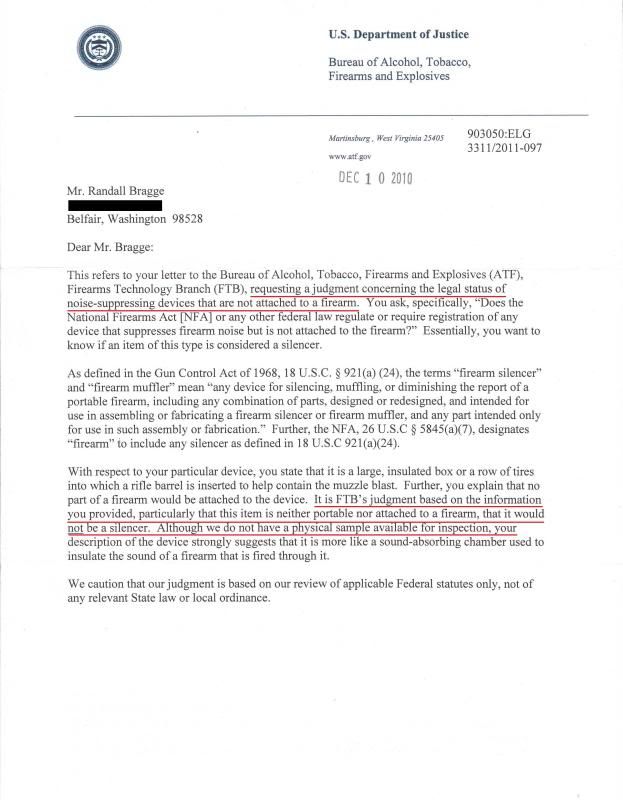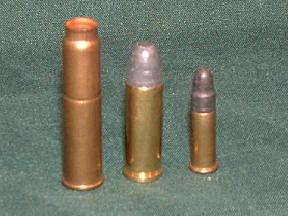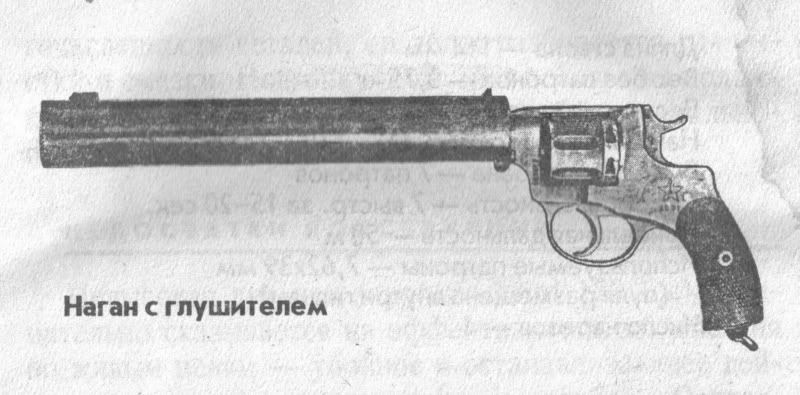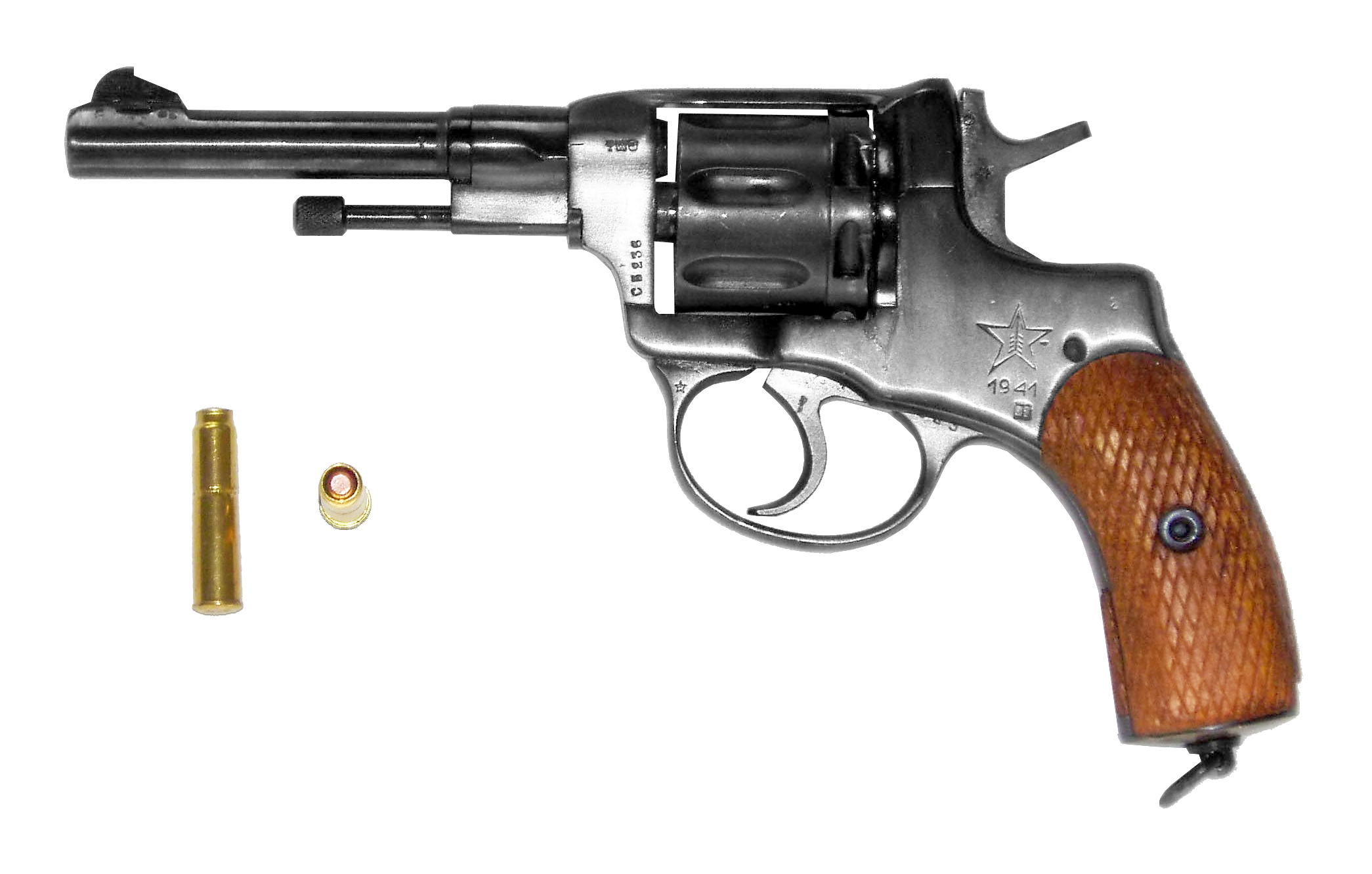You are using an out of date browser. It may not display this or other websites correctly.
You should upgrade or use an alternative browser.
You should upgrade or use an alternative browser.
barrel with offset bore ???
- Thread starter Magnum Wheel Man
- Start date
It seems that every time someone mentions revolvers and suppressors in the same sentence, someone has to bring up the Russian Nagant revolver. But has anyone actually seen, or seen an actual picture of, a Nagant being used with a suppressor? The only pictures I have seen of Russian suppressors have shown them used with auto pistols.
I have shot a suppressed Nagant I think it has a 9mm suppressor on it. It was very quiet because the ammo was subsonic and a revolvers action is much more quiet than a semi.
Mike Irwin
Staff
In order for something to be a suppressor, it must be attachable to the gun and, I believe, portable.
I got to looking around and found this.....

here......
http://www.silencertalk.com/forum3/viewtopic.php?f=2&t=72880

here......
http://www.silencertalk.com/forum3/viewtopic.php?f=2&t=72880
Sharkbite, I'm talking about the difference in tone between what you wrote to me here:
Especially in light of the letter posted above that shows a slightly different assignment of ignorance than you suggested.
...and your more recent "Thx" post to a Mod.You cant win a battle of wits with the willfully ignorant.
Especially in light of the letter posted above that shows a slightly different assignment of ignorance than you suggested.
Mike Irwin
Staff
"Good to know. Where did you get that info, cause its not stated thst way in the statue quoted above."
The letter that AK103K posted, and ones I saw when I worked for NRA and afterwards.
That said....
I've been away for a couple of days.
In reading this thread, I'm more than a bit displeased at the tone of some of the conversation that has gone on.
The sniping stops NOW, or I will put a very definitive end to it.
The letter that AK103K posted, and ones I saw when I worked for NRA and afterwards.
That said....
I've been away for a couple of days.
In reading this thread, I'm more than a bit displeased at the tone of some of the conversation that has gone on.
The sniping stops NOW, or I will put a very definitive end to it.
Mike Irwin
Staff
Now, on to the subject of revolvers and cylinder gap...
"As for suppressing a revolver, it might make a little bit of a difference in the overall sound, but probably not much; too much gas escapes from the cylinder/barrel gap."
In general, the above statement is true.
I HAVE fired revolvers with suppressors attached and which have not had a regulated cylinder gap.
While the report was certainly lessened, it was by NO means silent. Firing a .357 so equipped was NOT a good idea without hearing protection even though the gases exiting the muzzle were controlled.
I would describe the sound of the gas escaping the cylinder gap to be about as loud as a .22 LR or a .22 Magnum out of a pistol.
The reason the Russian Nagant revolver worked with a suppressor is because of the rather unique gas seal system in which the cylinder cammed forward and the mouth of the cartridge entered the forcing cone on the barrel.
This is a picture of a Nagant cartridge (free use from Wikipedia):

The bullet is fully enclosed below the neck crimp. On firing, the crimped brass expands and seals the cylinder gap. No gas escapes from the cylinder gap during firing.
This is a picture of a Bramit device, a Russian/Soviet designed suppressor for the Nagant revolver.

It was not the only design to be successfully used on the Nagant.
"As for suppressing a revolver, it might make a little bit of a difference in the overall sound, but probably not much; too much gas escapes from the cylinder/barrel gap."
In general, the above statement is true.
I HAVE fired revolvers with suppressors attached and which have not had a regulated cylinder gap.
While the report was certainly lessened, it was by NO means silent. Firing a .357 so equipped was NOT a good idea without hearing protection even though the gases exiting the muzzle were controlled.
I would describe the sound of the gas escaping the cylinder gap to be about as loud as a .22 LR or a .22 Magnum out of a pistol.
The reason the Russian Nagant revolver worked with a suppressor is because of the rather unique gas seal system in which the cylinder cammed forward and the mouth of the cartridge entered the forcing cone on the barrel.
This is a picture of a Nagant cartridge (free use from Wikipedia):
The bullet is fully enclosed below the neck crimp. On firing, the crimped brass expands and seals the cylinder gap. No gas escapes from the cylinder gap during firing.
This is a picture of a Bramit device, a Russian/Soviet designed suppressor for the Nagant revolver.

It was not the only design to be successfully used on the Nagant.
Mike Irwin
Staff
Model12Win
Moderator
...
For the MILLIONTH time now, people it's not a "Nagant", it is a "Mosin Nagant!"
Leon Nagant helped very little with the design of the rifle, and if you are going to call the Mosin Nagant anything it would be much more respectful and historically accurate to just say "Nagant".
Rant off.
-M12Winny
For the MILLIONTH time now, people it's not a "Nagant", it is a "Mosin Nagant!"
Leon Nagant helped very little with the design of the rifle, and if you are going to call the Mosin Nagant anything it would be much more respectful and historically accurate to just say "Nagant".
Rant off.
-M12Winny
Mike Irwin
Staff
Really?
You're coming into a thread about suppressed handguns, in the handgun forum, and you're bitching about the name of a RIFLE?
This is a Nagant revolver:

It is one of the subjects of discussion in this thread.
This is a Moisin Nagant rifle:

It is NOT one of the subjects of discussion in this thread.
You're coming into a thread about suppressed handguns, in the handgun forum, and you're bitching about the name of a RIFLE?
This is a Nagant revolver:

It is one of the subjects of discussion in this thread.
This is a Moisin Nagant rifle:

It is NOT one of the subjects of discussion in this thread.
...
For the MILLIONTH time now, people it's not a "Nagant", it is a "Mosin Nagant!"
Leon Nagant helped very little with the design of the rifle, and if you are going to call the Mosin Nagant anything it would be much more respectful and historically accurate to just say "Nagant".
Rant off.
-M12Winny
Straight from Wikipedia (Yeah, I realize it's not always accurate but...)
The Nagant M1895 Revolver is a seven-shot, gas-seal revolver designed and produced by Belgian industrialist Léon Nagant for the Russian Empire.
Designer
Emile & Léon Nagant
Designed
1886
Manufacturer
Nagant, Soviet Arsenals (Tula & Izhevsk), Państwowa Fabryka Karabinów[1]
Produced
1895-1945 (1895-1898 Nagant, 1899-1945 Tula, 1930 Warsaw, 1943-1945 Izhevsk)
I've never seen it designated as the '1895 mosin nagant'. You're thinking of the rifle.
Mike Irwin
Staff
Sweet baby Xenu that came in huge.
And the rifle didn't come in at all.
Doesn't matter, we're talking about HANDGUNS.
And the rifle didn't come in at all.
Doesn't matter, we're talking about HANDGUNS.
While the report was certainly lessened, it was by NO means silent. Firing a .357 so equipped was NOT a good idea without hearing protection even though the gases exiting the muzzle were controlled.
Considering it was a Magnum, that's not too surprising. A .357 Coonan is going to be plenty loud, too, fired through a suppressor. And the amount of gas escaping from the gap is going to be a function of total pressure.
Did anyone test fire that gun with standard .38s? That would be a closer comparison to a 9mm or .45 for total operating pressure.
Who's revolver was this, anyway?
Mike Irwin
Staff
"A .357 Coonan is going to be plenty loud, too, fired through a suppressor. And the amount of gas escaping from the gap is going to be a function of total pressure."
Maybe.
EVERYTHING and I mean EVERYTHING depends on the suppressor's ability to efficiently handle the volume of powder gas that is generated.
One size does NOT necessarily fit all.
Think of it this way, because it's an exact and appropriate analog -- the muffler on a car (a car muffler and the suppressor on a handgun have the exact same function, and often operate in very similar ways).
Souped up 1954 Chevy, 8 cylinder engine.
With the stock muffler it's plenty quiet.
With a Thrush performance glasspack, it has the ability to give your great grand kids headaches.
The difference is in the design of what the muffler is intended to do and how it processes the volume of gas from the engine.
As with car mufflers, in suppressors, one size does NOT fit all.
"That would be a closer comparison to a 9mm or .45 for total operating pressure."
A 9mm and the .357 Magnum operate in the same pressure band -- 30,000 to 35,000 PSI.
"Did anyone test fire that gun with standard .38s?"
Yes.
It was still in the range of a .22 Long Rifle, maybe a bit quieter, but still MORE than loud enough to A) make the suppressor hanging off the end of the muzzle pretty much worthless and B) Not the dainty little bunny farts that some apparently think it would produce.
Maybe.
EVERYTHING and I mean EVERYTHING depends on the suppressor's ability to efficiently handle the volume of powder gas that is generated.
One size does NOT necessarily fit all.
Think of it this way, because it's an exact and appropriate analog -- the muffler on a car (a car muffler and the suppressor on a handgun have the exact same function, and often operate in very similar ways).
Souped up 1954 Chevy, 8 cylinder engine.
With the stock muffler it's plenty quiet.
With a Thrush performance glasspack, it has the ability to give your great grand kids headaches.
The difference is in the design of what the muffler is intended to do and how it processes the volume of gas from the engine.
As with car mufflers, in suppressors, one size does NOT fit all.
"That would be a closer comparison to a 9mm or .45 for total operating pressure."
A 9mm and the .357 Magnum operate in the same pressure band -- 30,000 to 35,000 PSI.
"Did anyone test fire that gun with standard .38s?"
Yes.
It was still in the range of a .22 Long Rifle, maybe a bit quieter, but still MORE than loud enough to A) make the suppressor hanging off the end of the muzzle pretty much worthless and B) Not the dainty little bunny farts that some apparently think it would produce.
Mike,
The numbers you're quoting are peak pressure. Total perating pressure is what actually produces the muzzle ballistics. 9mm has a high peak pressure because it has to do what something like .38 does with a much smaller case. But once the bullet is going down the bore the pressures become comparable. And that's what the suppressor has to contend with.
Peak pressures are mainly important for engineering chamber strength and regulating blowback actions.
But if the .38s were also awful loud, that answer the question to my satisfaction.
The numbers you're quoting are peak pressure. Total perating pressure is what actually produces the muzzle ballistics. 9mm has a high peak pressure because it has to do what something like .38 does with a much smaller case. But once the bullet is going down the bore the pressures become comparable. And that's what the suppressor has to contend with.
Peak pressures are mainly important for engineering chamber strength and regulating blowback actions.
But if the .38s were also awful loud, that answer the question to my satisfaction.
I don't think it has anything to do with being a 'magnum.'Considering it was a Magnum, that's not too surprising.
Subsonic loads always help, but there are very quiet suppressed .44mags and .357 magnums. The difference is they're often quiet because they're used in a single shot, lever, or bolt action which often don't let any gases escape from anywhere but the muzzle. I don't think a milder cartridge would make much difference in a 'suppressed' revolver, without any type of gas seal, unless you're talking about super mild 'cowboy loads' that barely use any powder and then, the only difference would be because less powder = less gasses escaping the cylinder gap. The gap is still the problem.
Sure, it's the problem. But as those two constrasting pictures of firing revolvers demostrate, the amount of gas that comes out of a magnum or any souped up caliber is considerable.
This is the reason that super hot cartidges are favored for compensated IPSC guns - more pressure=more gas=more results.
This is the reason that super hot cartidges are favored for compensated IPSC guns - more pressure=more gas=more results.
